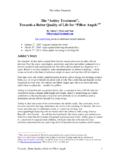Transcription of Parallels Between Zechariah 1:7-6:15 and Revelation 4:1-6:8
1 Modified 08/05/10 Page 1 Parallels Between Zechariah 1:7-6:15 and Revelation 4:1-6:8 Copyright (c) 2010 by Frank W. Hardy, Introduction1 Much of what John writes in Rev 4-5 and the first four of the seven seals (6:1-8 = Rev 6a) is modeled on Zech 3-6, with secondary awareness of Zech 1-2. The Parallels are most instructive. We discuss them in three stages. First we relate Zech 3-6 to Rev 4-6a, then Zech 1-2 to 3-6, then Zech 1-2 to Rev 4-6a. Zechariah is a twin prophecy to Haggai. Haggai was written in the second year of Darius (520 BC), with datelines of year 2, month 6, day 1 (1:1); year 2, month 6, day 24 (1:15); [year 2,] month 7, day 20 (2:1); and year 2, month 9, day 24 (2:10); [year 2,] month 9, day 24 (2:18); and [year 2, month 9,] day 24 (2:20). Zechariah begins in the second year of Darius as well, with datelines of year 2, month 8 (1:1) and year 2, month 11, day 24 (7:1); but goes beyond this with a dateline of year 4, month 9, day 4 (7:1).
2 The context for both books is the Jews' return from Babylonian captivity after the seventy years prophecy of Jeremiah (25:11, 12; 29:10). The exile is an important piece of contextual information here that we neglect at our peril. No one will ever understand Haggai or Zechariah without an awareness of the exile (more specifically the recent return from exile), which gives these prophecies their reason for existence. Similarly, no one will ever understand Rev 4-6a without an awareness of the material John had in mind while writing it. The thesis of this paper is that the material he had in mind was Zech 3-6. The Parallels discussed below do not represent isolated verses selected at random, but rather a series of representative excerpts from an extended body of text four of the fourteen chapters (29%) of Zechariah , or almost a third of the book.
3 In Rev 4-6a it is as though John picked up Zech 3-6, with secondary awareness of Zech 1-2, wrung out some white space, and set the chapters down in his own prophecy immediately following the seven churches. Zechariah 3-6 and Revelation 4-6a There are at least four thematic Parallels Between Zech 3-6 and Rev 4-6a. The themes or figures from Zechariah that we examine here are: (1) the clothing and crowning of Joshua the high priest (Zech 3:1-5), (2) the seven eyes of the LORD that go out into all the earth (Zech 3:9; 4:2, 10), (3) the flying scroll with writing on both sides (Zech 5:1-4), and (4) the four teams of different colored horses (Zech 6:1-5). 1 I would like to thank Alberto Treiyer for commenting on an earlier version of this paper. Hardy Zechariah Page 2 Joshua the high priest Then he showed me Joshua the high priest standing before the angel of the LORD, and Satan standing at his right side to accuse him.
4 2 The LORD said to Satan, "The LORD rebuke you, Satan! The LORD, who has chosen Jerusalem, rebuke you! Is not this man a burning stick snatched from the fire?" 3 Now Joshua was dressed in filthy clothes as he stood before the angel. 4 The angel said to those who were standing before him, "Take off his filthy clothes." Then he said to Joshua, "See, I have taken away your sin, and I will put rich garmentsrich garmentsrich garmentsrich garments on you." 5 Then I said, "Put a clean turbanturbanturbanturban [ n p] on his head." So they put a clean turbanturbanturbanturban on his head and clothed him, while the angel of the LORD stood by. ( Zechariah 3:1-5)2 Joshua. Joshua is here dressed in filthy clothes. Ellen White applies this figure to us, on the comparison that filthy clothes represents the guilt of our sin. She compares the changing of Joshua's clothing to our putting on the garments of salvation.
5 Your heavenly Father will take from you the garments defiled by sin. In the beautiful parabolic prophecy of Zechariah , the high priest Joshua, standing clothed in filthy garments before the angel of the Lord, represents the sinner. And the word is spoken by the Lord, "Take away the filthy garments from him. And unto him He said, Behold, I have caused thine iniquity to pass from thee, and I will clothe thee with change of raiment.. So they set a fair miter upon his head, and clothed him with garments." Zechariah 3:4, 5. Even so God will clothe you with "the garments of salvation," and cover you with "the robe of righteousness." Isaiah 61:10. "Though ye have lien among the pots, yet shall ye be as the wings of a dove covered with silver, and her feathers with yellow gold." Psalm 68:13. {COL } Was the guilt symbolized by Joshua's clothing his own?
6 The assumption so far has been that it was (see vs. 4). "All have sinned and fall short of the glory of God" (Rom 6:23). This would include Joshua as it would include every other high priest back to Aaron but I personally doubt that focusing on Joshua's own guilt exhausts the meaning of the passage. The whole thing about being a high priest, or any priest, is that you represent others in their dealings with God. In the context of the exile, all Israel had sinned and incurred guilt. That was the reason for the exile. God was not acting capriciously when He drove His people from their homeland. They well deserved their punishment (see Dan 9:1-19). As their high priest, Joshua was the representative of the entire nation in spiritual things. As such, and with no remaining temple, he would have been the only one capable of bearing their sin.
7 Now God was removing not just his sin, but their sin, and bringing His people back again from exile. Removing Joshua's filthy clothes was symbolic of an act of corporate forgiveness on God's part. By virtue of his office every high priest was a type of Christ, who would one day come and minister as the great antitypical High Priest in the heavenly sanctuary. Or is this true? Was it every high priest, or every high priest except Joshua? Does the fact that Joshua sinned unfit him from typifying Christ? If so, no high priest could typify Him. And yet we just pointed out that every high priest did. The basis for the typical significance of the high priesthood was not the 2 Unless marked otherwise, English Bible quotations are from The Holy Bible: New International Version . NIV . Copyright 1973, 1978, 1984 by International Bible Society.
8 Used by permission of Zondervan Publishing House. Hardy Zechariah Page 3 individual holding the office, but the office itself. Thus there is nothing in Zech 3 to keep us from seeing the Parallels John saw Between Joshua and the Lamb. In the type, Joshua's act of changing clothes had to do with God restoring His people to favor, assuring them that He had once more chosen Jerusalem, allowing them to return home from Babylonian exile. In the antitype there are two possible interpretations. In an inauguration model, which places Rev 4-5 in the first century, Joshua's putting on of a clean turban is reminiscent of a coronation ceremony. One problem with this alternative is that a turban is not the only thing Joshua puts on. He undergoes a complete change of clothing. "So they put a clean turban on his head and clothed him, while the angel of the LORD stood by" (vs.)
9 5, emphasis added). A coronation would normally focus only on the crown, whereas Zechariah does not limit himself in this In a judgment model, which places Rev 4-5 in the end time, the fact that a high priest changes into special clothes calls to mind his preparation for ministry in the second He is to put on the sacred linen tunic, with linen undergarments next to his body; he is to tie the linen sash around him and put on the linen turbanthe linen turbanthe linen turbanthe linen turban. These are sacred garments; so he must bathe himself with water before he puts them on. (Leviticus 16:4) Satan. In Zech 3:1-5 the cast of characters includes "Joshua the high priest," "the angel of the LORD," and "Satan [ha n]" there "to accuse [l a n ] him," , to accuse Joshua (vs. 1). Since there is an accusation, there is a disagreement. If there is a disagreement and Satan is taking one position (accusing), could we say that the Angel of the LORD is taking a different position (defending)?
10 After the accusation and the defense, the LORD, before whom all this has been taking place, issues a verdict, "'The LORD rebuke you, Satan!'" (vs. 2). If the accusation and defense of Joshua takes place before the LORD, and if having heard the arguments He issues a verdict, He is occupying the role of a Judge (see Gen 18:25). This is not the entire cast. Others "were standing before him" (vs. 4). "If you will walk in my ways and keep my requirements, then you will govern my house and have charge of my courts, and I will give you a place among these standing here" (vs. 7). Those standing in vs. 4 and again in vs. 7 cannot be the same as "your associates seated before you" in vs. 8, because those "before" the LORD are standing, whereas those "before" Joshua (his associates) are seated. This entire setting sounds very much like a court. Then he showed me Joshua the high priestJoshua the high priestJoshua the high priestJoshua the high priest standing before the angel of the LORDthe angel of the LORDthe angel of the LORDthe angel of the LORD, and SatanSatanSatanSatan standing at his right side to accuse him.







